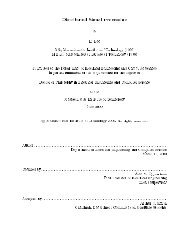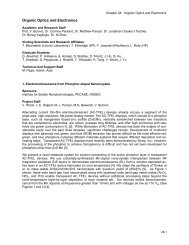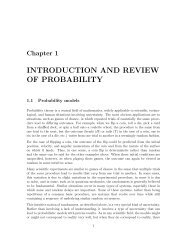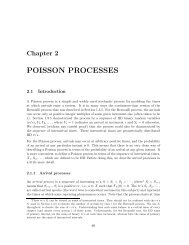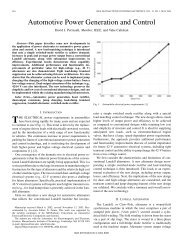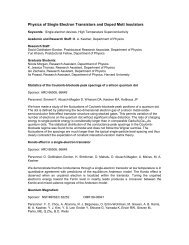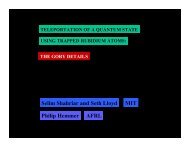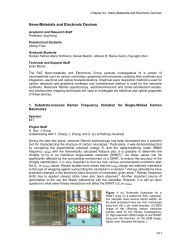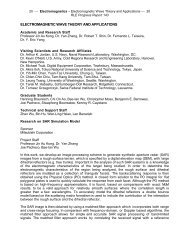A 24 Gb/s Software Programmable Analog Multi-Tone - Research ...
A 24 Gb/s Software Programmable Analog Multi-Tone - Research ...
A 24 Gb/s Software Programmable Analog Multi-Tone - Research ...
Create successful ePaper yourself
Turn your PDF publications into a flip-book with our unique Google optimized e-Paper software.
IEEE JOURNAL OF SOLID-STATE CIRCUITS, VOL. 43, NO. 4, APRIL 2008 999<br />
A <strong>24</strong> <strong>Gb</strong>/s <strong>Software</strong> <strong>Programmable</strong> <strong>Analog</strong><br />
<strong>Multi</strong>-<strong>Tone</strong> Transmitter<br />
Amir Amirkhany, Member, IEEE, Aliazam Abbasfar, Senior Member, IEEE, Jafar Savoj, Senior Member, IEEE,<br />
Metha Jeeradit, Student Member, IEEE, Bruno Garlepp, Member, IEEE, Ravi T. Kollipara, Senior Member, IEEE,<br />
Vladimir Stojanovic, Member, IEEE, and Mark Horowitz, Fellow, IEEE<br />
Abstract—A <strong>24</strong> <strong>Gb</strong>/s transmitter employs a digital linear equalizer<br />
and a 12 GS/s 8-bit digital-to-analog converter (DAC). Implemented<br />
in a 90 nm CMOS technology, the transmitter can be programmed<br />
to support a variety of communication modes including<br />
4-channel and 2-channel analog multi-tone (AMT), as well as various<br />
baseband (BB) modes ranging from 2 to 256 PAM. Selection of<br />
the transmission mode is enabled through software programming<br />
of the appropriate tap coefficients into the equalizer. The transmitter<br />
dissipates 510 mW of power and is fabricated over an area<br />
of 0.8 mm 2 . Experimental results confirm clear eye diagrams at 28<br />
<strong>Gb</strong>/s.<br />
Index Terms—Decision feedback equalizers, equalizers, frequency<br />
division multiplexing, high-speed circuits, MIMO systems.<br />
I. INTRODUCTION<br />
MODERN high-speed electrical links enable transmission<br />
of data at multi-gigabits per second between integrated<br />
circuits. Examples of such links include the network routers<br />
in the backbone of the internet, the interface between a controller<br />
and multiple memory modules inside a personal computer<br />
(PC), or the interface between the central and the graphics<br />
processing units (CPU and GPU) inside a PC. In all these applications<br />
the communication media are copper traces on printed<br />
circuit boards (PCB). Signal quality of such channels is distorted<br />
by various loss mechanisms as well as reflections from<br />
the impedance discontinuities in the signal path. The latter are<br />
caused by the vias, stubs, and connectors necessary to route the<br />
signal traces across PCB layers and multiple boards. Signal reflections<br />
caused by these discontinuities create resonance frequencies<br />
and result in notches in the frequency response of the<br />
link channels. Fig. 1(a) shows the frequency response of three<br />
different channels used for backplane [see Fig. 1(b)], multi-drop<br />
[see Fig. 1(c)], and chip-to-chip [see Fig. 1(d)] communications.<br />
Manuscript received August <strong>24</strong>, 2007; revised October 29, 2007.<br />
A. Amirkhany is with Rambus Inc., Los Altos, CA 94022 USA and also with<br />
the Department of Electrical Engineering, Stanford University, Stanford, CA<br />
94305 USA (e-mail: amirkhany@stanford.edu).<br />
A. Abbasfar, M. Jeeradit, and R. T. Kollipara are with Rambus Inc., Los Altos,<br />
CA 94022 USA.<br />
J. Savoj was with Rambus Inc, Los Altos, CA 94022 USA. He is currently<br />
with Qualcomm, Campbell, CA 95008 USA.<br />
B. Garlepp was with Rambus Inc., Los Altos, CA. He is currently with SiTime<br />
Corp., Sunnyvale, CA 94085 USA.<br />
V. Stojanovic is with the Department of Electrical Engineering, Massachusetts<br />
Institute of Technology, Cambridge MA 02139 USA.<br />
M. Horowitz is with the Department of Electrical Engineering, Stanford University,<br />
Stanford, CA 94305 USA, and also with Rambus Inc., Los Altos, CA<br />
94022 USA.<br />
Digital Object Identifier 10.1109/JSSC.2008.917520<br />
Due to the tight constraints on the power consumption of<br />
high-speed links and their extremely high operating rates, the<br />
majority of the state-of-the-art links employ 2 PAM BB signaling<br />
with relatively simple signal processing to compensate<br />
for the dispersive nature of the channel [1], [2]. A state-ofthe-art<br />
BB link generally includes a discrete linear equalizer<br />
at the transmitter to cancel precursor inter-symbol interference<br />
(ISI), a linear peaking amplifier at the receiver front-end to increase<br />
sensitivity and compensate for the magnitude distortion<br />
of the channel, and a decision feedback equalizer (DFE) at the<br />
receiver to cancel post-cursor ISI. Recently, links that additionally<br />
utilize a low-resolution analog-to-digital converter (ADC)<br />
and a digital feed-forward equalizer (FFE) at the receiver have<br />
also been demonstrated [3]. Commercial links today generally<br />
operate at data transfer rates of 6 to 12.5 <strong>Gb</strong>/s and power-efficiencies<br />
of less than 30 mW/<strong>Gb</strong>/s, while prototype systems<br />
have achieved data rates of 20 <strong>Gb</strong>/s [4] or power efficiencies<br />
of 2.2 mW/<strong>Gb</strong>/s [2].<br />
A study of the limits of signaling in backplane links [5],<br />
however, reveals that there is a large gap between the fundamental<br />
limits of signaling, commonly known as the Shannon capacity,<br />
and the limits achievable with BB signaling techniques.<br />
In particular, inspection of the channel characteristics, shown<br />
in Fig. 1, reveals that, in a class of applications, notches in<br />
the frequency domain are part of the frequency response of the<br />
link channels. It is well known in communication theory that<br />
multi-tone (MT) signaling has the potential to achieve superior<br />
performance over such channels compared to BB signaling by<br />
better allocation of the transmit energy and avoiding wasting energy<br />
over the notch frequencies. MT signaling can therefore be<br />
employed to potentially reduce the gap between current link performances<br />
and the Shannon capacity in these applications. However,<br />
as it is usually the case in link environments, the real challenge<br />
lies in the implementation. Implementing conventional<br />
MT techniques, like discrete multi-tone (DMT), which is widely<br />
used in digital subscriber line (DSL) and wireless systems, is not<br />
energy-efficient at the multi-gigabit per second operating rates<br />
necessary for high-speed links [6]. This is because such MT<br />
techniques require high-speed moderate-resolution ADCs at the<br />
receiver and relatively sophisticated digital signal processing,<br />
which significantly add to the total system power consumption.<br />
We recently proposed an MT technique, called analog multitone<br />
(AMT), which is customized to the link characteristics<br />
and has the potential to achieve superior performance compared<br />
to BB systems while being energy efficient in a link environment<br />
[7]. Similar to a BB link, an AMT link employs linear<br />
transmit equalization and receive DFE to compensate for the<br />
0018-9200/$25.00 © 2008 IEEE
1000 IEEE JOURNAL OF SOLID-STATE CIRCUITS, VOL. 43, NO. 4, APRIL 2008<br />
Fig. 1. (a) Channel characteristics in frequency domain. (b) An electrical link in a network router. (c) A multi-drop memory interface. (d) A CPU-GPU link.<br />
effects of the band-limited channel. This paper describes the<br />
design of a <strong>24</strong> <strong>Gb</strong>/s software programmable transmitter, implemented<br />
in a 90 nm CMOS technology, which supports 4-channel<br />
and 2-channel AMT as well as a variety of BB transmission<br />
modes including 2 and 4 PAM. With 16 effective FFE taps,<br />
10-bit tap coefficients, and no constraints on the dynamic range<br />
of the taps, the transmitter has sufficient equalization capabilities<br />
to enable the study of both AMT and BB transmission algorithms<br />
over a wide range of environments and applications. In<br />
other words, the transmitter is an extremely flexible test instrument<br />
for high-speed link applications. The transmitter architecture<br />
was originally described in [8].<br />
Section II reviews the architecture of an AMT system and<br />
its operation from both time domain and frequency domain<br />
perspectives. With this understanding of the overall system,<br />
Section III describes the architecture of the transmitter, and<br />
measurement results follow in Section IV. The architecture of<br />
the equalizer also enables compensation of analog distortions<br />
caused by the mismatch in the paths of the on-chip time-interleaved<br />
DAC through cyclic time-variant equalization. Section V<br />
explains how this correction is done and also provides results<br />
for the multi-PAM BB operation modes supported by the<br />
transmitter.<br />
II. ANALOG MULTI-TONE<br />
In order to have an energy-efficient MT architecture at the<br />
extremely high operation rates necessary for high-speed links,<br />
a BB link can be extended into a bank of parallel links operating<br />
at different carrier frequencies. Fig. 2(a) shows a conceptual<br />
MT system based on this idea. Each sub-channel (the path<br />
from an input at the transmitter to the corresponding output at<br />
the receiver) in this figure can potentially have a bandwidth<br />
of a few gigahertz and only a small number of sub-channels<br />
may exist. This architecture is, however, difficult to implement<br />
since fully integrated filters with sharp roll-off are not available.<br />
Therefore, energy from one sub-channel will inevitably spill<br />
over to the neighboring sub-channels, causing inter-channel interference<br />
(ICI). ICI is similar to ISI in nature, with the exception<br />
that it represents interference from symbols from another<br />
sub-channel. Therefore, as long as the transfer function from the<br />
input of the interfering sub-channel to the output of the target<br />
sub-channel does not change from sample to sample, i.e., as<br />
long as the system is linear time invariant (LTI) in the discrete<br />
domain, ICI can be cancelled in the same way as ISI; through<br />
equalization.<br />
For the system to be considered LTI in the discrete domain,<br />
the following two constraints should be fulfilled:<br />
1) all sub-channel symbol rates should be the same;<br />
2) all carrier frequencies should be integer multiples of the<br />
sub-channel symbol rate.<br />
These two constraints will cause all carrier frequencies<br />
to complete full cycles from one symbol to another. This<br />
means that from the input sequences’ perspective the system<br />
does not change from one cycle to another, and is therefore<br />
time-invariant in the discrete domain. However, ISI and<br />
ICI cancellation in this multi-input–multi-output (MIMO)<br />
system requires MIMO linear transmit equalization and MIMO<br />
receive DFE [9]. Alternatively, it can be shown that as a<br />
consequence of the two constraints imposed on the system,<br />
for an -sub-channel system, the MIMO transmit equalizer,<br />
the low-pass filters, and the mixers in the transmitter can be
AMIRKHANY et al.: A <strong>24</strong> GB/S SOFTWARE PROGRAMMABLE ANALOG MULTI-TONE TRANSMITTER 1001<br />
Fig. 2. (a) Conceptual multi-tone system with low-pass filters and mixers at the transmitter and receiver to create band-limited sub-channels. X ; ...;X are<br />
input sequences. (b) AMT architecture with per-sub-channel linear N -times over-sampled equalizers at the transmitter, and mixer and integrate-and-dump at the<br />
receiver.<br />
replaced by -times 1 over-sampled equalizers per sub-channel<br />
[7]. An appropriate choice for the low-pass filter in the receiver<br />
that leads to superior performance and can be implemented<br />
reliably on chip is an integrate-and-dump circuit that integrates<br />
over one sub-channel symbol period [10]. Fig. 2(b) shows the<br />
finalized AMT architecture. In the architecture of Fig. 2(b),<br />
each -times over-sampled equalizer can shape the transmission<br />
bandwidth (from dc to the Nyquist frequency) of the entire<br />
system. Therefore, when all the sub-channel equalizers are<br />
optimized simultaneously, they work together to cancel both<br />
ISI and ICI at the same time.<br />
From a time-domain perspective, the AMT system is a transmultiplexer<br />
operating based on the principle of perfect reconstruction<br />
[11]. As an example, the time-domain waveforms of<br />
a 2-channel AMT system are plotted in Fig. 3(a) to illustrate<br />
this point further. In this example, the transmit equalizers are<br />
2-times over-sampled 2-tap filters, a zero-order hold filter performs<br />
discrete-to-analog conversion, the channel is assumed to<br />
be ideal, and there is no MIMO DFE in the receiver. Continuous<br />
time ISI and ICI patterns at the input to the samplers are<br />
also shown along with the sampled sequences and . It can<br />
be seen that even though the transmit equalizers are very short,<br />
and consequently, significant energy overlap exists between the<br />
1 N -times with respect to sub-channel symbol rate. Assuming all sub-channels<br />
are 2 PAM, each sub-channel equalizer is operating at the overall data rate<br />
of the link.<br />
two sub-channels at the transmitter output, both the ISI and the<br />
ICI are forced to zero at the sampling points at the receiver. As<br />
a result, and are fully recovered at the sampler outputs<br />
without any interference. However, the ISI and the ICI are not<br />
necessarily zero at points other than the sampling point. This is<br />
very similar to the operation of an equalized BB system where<br />
a linear equalizer forces the ISI to zero (only) at the sampling<br />
points.<br />
Ignoring the MIMO DFE, for large number of sub-channels,<br />
the AMT system shown in Fig. 2(b) is a very inefficient implementation<br />
of a DMT system in which the IFFT operation at<br />
the transmitter is performed using -times over-sampled equalizers.<br />
However, for a small number of sub-channels, the AMT<br />
system is highly efficient and its performance is not limited by<br />
cyclic prefix overhead [12]—a limiting factor in small-blocksize<br />
DMT systems. In fact, it can be shown that the equalization<br />
complexity (and consequently equalization power) of the AMT<br />
system is comparable to a BB system operating at the same<br />
overall throughput. To demonstrate this point further, Fig. 3(b)<br />
shows a 2-way parallelized 4-tap BB transmit equalizer and a<br />
4-tap-per-channel 2-channel AMT equalizer. The BB and AMT<br />
equalizers look structurally identical except that the taps in the<br />
lower branch of the 2-way parallelized BB equalizer are constrained<br />
to be a shifted version of the upper branch. The taps<br />
in the two branches of the AMT equalizer, on the other hand,<br />
have more degrees of freedom and can take values indepen-
1002 IEEE JOURNAL OF SOLID-STATE CIRCUITS, VOL. 43, NO. 4, APRIL 2008<br />
Fig. 3. (a) Signal waveforms in an example 2-channel AMT system. Two-tap equalizers per sub-channel at the transmitter, ideal channel, and no DFE at the<br />
receiver. Continuous-time ISI and ICI patterns are shown at the sampler inputs. (b) A 2-way parallelized 4-tap linear equalizer and a 2-channel 4-tap per channel<br />
AMT equalizer.<br />
dently. 2 In other words, the AMT equalizer is a general form<br />
of a BB equalizer. The additional degrees of freedom in the<br />
AMT equalizer enable the AMT system to shape the transmit<br />
spectrum better than a BB system. As a result, an AMT system<br />
performs considerably better than a BB system over channels<br />
with notches in their frequency response or in the presence of<br />
frequency selective interference, where optimal shaping of the<br />
transmit spectrum is crucial. Over smooth channels, however,<br />
where both AMT and BB can achieve close to optimum transmit<br />
power allocation, for the same transmit peak voltage, the AMT<br />
system can put less signal energy on the line compared to a BB<br />
system, because a MT signal in general has a higher peak-to-average<br />
power ratio (PAPR) than a single-tone signal. Therefore,<br />
BB signaling may be optimal for signal transmission over these<br />
kinds of channels.<br />
Fig. 3(b) also indicates that an AMT transmitter can be built<br />
to support BB signaling with very small overhead. Such a transmitter<br />
can achieve the best performance over a very wide range<br />
of channel characteristics using either AMT or BB transmission<br />
depending on which one is optimal. Section VII describes this<br />
type of transmitter designed to support <strong>24</strong> <strong>Gb</strong>/s in both AMT<br />
and BB modes.<br />
III. TRANSMITTER ARCHITECTURE<br />
The <strong>24</strong> <strong>Gb</strong>/s transmitter, fabricated in a 90 nm CMOS technology,<br />
includes an on-chip pattern generator (PG), a linear<br />
2 Same complexity (power) argument applies to the MIMO DFE in the receiver<br />
of the AMT system as well, and the argument is independent of whether<br />
FFE and DFE are implemented in digital domain or as pseudo-DAC current<br />
mode equalizers.<br />
equalizer, and a DAC. The design of the equalizer in the digital<br />
domain, with 16 10-bit full-range taps, makes the transmitter<br />
a platform with sufficient flexibility to enable evaluation<br />
of different transmission algorithms in different environments.<br />
Fig. 4(a) shows the top level block diagram of the transmitter.<br />
The PG creates <strong>24</strong> <strong>Gb</strong>/s of pseudo-random (PN) binary data<br />
for the system in the form of four (2-way parallelized) 3 GS/s<br />
4 PAM (or 2 PAM) sequences. The 16-tap linear equalizer is<br />
parallelized four ways with each parallel branch allowed to take<br />
independent tap values. This way the transmitter can be configured<br />
to support 4-channel and 2-channel AMT, as well as<br />
multi-PAM BB signal transmission ranging from 2 to 256 PAM.<br />
Each parallel branch of the equalizer is 2-way parallelized to operate<br />
with a 1.5 GHz clock and receives a 4 PAM (or 2 PAM) sequence<br />
as input. A thermometer encoder, included at the output<br />
stage of the equalizer, converts the three most significant bits<br />
of the output to unary code. An on-chip 8-bit 12 GS/s 2-way<br />
output multiplexed current-mode DAC converts the digital outputs<br />
to an analog signal and directly drives the 50- chip output.<br />
Fig. 4(b) shows the clock network of the transmitter. The<br />
system uses an external 12-GHz reference signal along with<br />
CML frequency dividers to minimize the impact of clock jitter<br />
and achieve optimum duty cycle for the synchronizing half-rate<br />
clock. The 6 GHz half-rate clock is further divided on-chip to<br />
create the 3 GHz clock required for the DAC, and the 1.5 GHz<br />
clock required for the digital equalizer and the PG. A phase interpolator<br />
and a phase detector are placed at the interface between<br />
the DAC and the equalizer to ensure the two circuits have<br />
independent clock distribution networks without potential setup
AMIRKHANY et al.: A <strong>24</strong> GB/S SOFTWARE PROGRAMMABLE ANALOG MULTI-TONE TRANSMITTER 1003<br />
Fig. 4. (a) Transmitter block diagram. (b) Transmitter clock network. Black dots in the equalizer indicate the placement of the clock drivers. A phase interpolator<br />
(PI) shifts the phase of the input clock to the transmitter based on information from a phase detector (PD). The phase detector samples a 1.5 GHz clock that branches<br />
off from a leaf of the equalizer’s clock grid with the 3 GHz input clock to the DAC.<br />
and hold violations at their common interface. The phase detector<br />
samples a 1.5 GHz clock that branches off from the equalizer<br />
network with the 3 GHz in-phase clock and provides information<br />
on the phase alignment of the two clocks. The phase interpolator<br />
is programmed offline based on this information. The<br />
1.5 GHz clock distribution inside the equalizer is in the form<br />
of an 8-mesh with the clock being routed from the sides toward<br />
the center, in the direction of the data flow [see Fig. 5(a)]. The<br />
PG block, implemented with standard library cells following a<br />
full ASIC flow, operates with a 375 MHz clock, with the exception<br />
of a small block of serializers at the output stage which<br />
operate with a 1.5 GHz clock. The 1.5 GHz clock for the PG<br />
also branches off from the equalizer network, and the 1.5 GHz<br />
clock distribution latency in the PG is included in the critical<br />
path of the data interface between the equalizer and the PG.<br />
The equivalent functionality of the equalizer is a 16-tap FIR<br />
filter with 10-bit tap coefficients and 2-bit (4 PAM) inputs operating<br />
at 12 GS/s. Fig. 5(a) shows the datapath of one phase of<br />
the 4-phase equalizer. The relative placement of the blocks is<br />
chosen to minimize power dissipation in the long wires. In one<br />
phase, 16 10-bit by 2-bit multiplications are performed and the<br />
results are summed in one 3 GHz cycle. For multiplications, the<br />
10-bit values of W and 3 W (where W is an equalizer tap coefficient)<br />
are stored in flip-flops and a 4:1 multiplexer selects the<br />
correct multiplication output ( Wor 3 W) based on the 2-bit<br />
data input. The flip-flops storing the tap coefficients do not dissipate<br />
any active power and only impose a small area overhead.<br />
Additions are performed with three stages of 4:2 compressor<br />
units and a final pseudo Kogge–Stone adder. In this design, the<br />
compressor architecture proposed in [14] was used, except that<br />
parts of the logic were duplicated to create true and complementary<br />
outputs in parallel to reduce the total number of logic stages<br />
in the critical path (see Fig. 6). Optimizing the compressors to<br />
meet a 3.0 GHz cycle time would lead to larger area and higher<br />
power consumption than a 2-way parallelized architecture to<br />
meet a 1.5 GHz cycle. Consequently, the design was 2-way parallelized<br />
to operate with a 1.5 GHz clock and each compression<br />
was placed in a separate pipeline stage. Overall, the equalizer<br />
has five stages of pipelining, with flip-flops placed before every<br />
compressor, before the final adder and before the thermometer<br />
encoder. A final 2:1 multiplexer that converts the 1.5 GHz odd<br />
and even outputs to a 3.0 GHz output is placed after the thermometer<br />
encoder and precedes the long output wires. The thermometer<br />
encoder was sized to settle in a 3.0 GHz cycle to reduce<br />
the transient power dissipated on the long output wires.<br />
The equalizer is implemented in static logic and transistor<br />
sizing of the building components is fully custom. However,<br />
these building components are further characterized as standard<br />
cells to enable the automation of the design using a combination<br />
of several commercial ASIC design tools, including a<br />
synthesis and a place and route (P&R) tool, in addition to an<br />
in-house hierarchical MATLAB placement tool. The MATLAB
1004 IEEE JOURNAL OF SOLID-STATE CIRCUITS, VOL. 43, NO. 4, APRIL 2008<br />
Fig. 5. (a) Datapath of one phase of the equalizer consisting of three stages of 4:2 compression, a pseudo Kogge–Stone adder and a thermometer encoder. Each<br />
block is 2-way parallelized and a 2:1 multiplexer (serializers) is included in the thermometer encoder. (b) Equalizer floorplan in the Matlab placement tool. Large<br />
rectangles on the sides are areas where low-speed flip-flops holding equalizer tap coefficients are placed by the P&R tool. Large rectangles in the middle column<br />
are areas where the adder and the thermometer encoder are placed by the P&R tool. The small isolated blocks in the middle row are latches, implementing the shift<br />
registers for the input data sequence. X- and Y -axes show actual sizes in microns.<br />
tool interacts with the P&R tool to place high-speed components<br />
at exact desired locations. Fig. 5(b) shows the complete floorplan<br />
of the equalizer. Routing is fully handled by the P&R tool<br />
and verification is performed with commercial Static Timing<br />
Analysis tools. The overall flow has a precision close to a full<br />
custom design while utilizing the vast automation and verification<br />
capabilities of the commercial ASIC design tools [17]. The<br />
equalizer was designed to meet the <strong>24</strong> <strong>Gb</strong>/s specification in the<br />
SS/125 /0.95 V corner. Correct operation was observed in the<br />
lab at room temperature and nominal supply at 29 <strong>Gb</strong>/s before<br />
the clocking circuitry start to break.<br />
In order to achieve superior linearity and higher operation<br />
speeds, data multiplexing and current switching are combined<br />
within the same circuit inside the DAC cell. The 6-GHz synchronizing<br />
clock signal utilizes CML swings to avoid device<br />
stress in presence of a 1.8-V termination voltage. Calibration is<br />
performed so that the multiplexing 6-GHz clock is centered with<br />
respect to the data bits. The calibration process consists of two<br />
steps. In the first step, two binary phase detectors identify the<br />
zero crossings of the 6 GHz clock with respect to the two 6 <strong>Gb</strong>/s<br />
LSB signals. Consequently, a fixed phase offset is added to the<br />
data bits. The circuit utilizes inductive techniques to increase the<br />
clock driver and the output termination bandwidths. The design<br />
of the DAC is described in [13]. The circuit can achieve higher<br />
operation speeds if the clock dividers and the 6-GHz driver are<br />
redesigned to achieve an even higher bandwidth.<br />
IV. MEASURED TRANSMITTER PERFORMANCE<br />
Fig. 7 shows the measured eye diagrams in different operation<br />
modes. The three figures to the left show the eye diagrams<br />
captured on an equivalent-time scope when the transmitter is operating<br />
in BB mode. In AMT mode, the eye diagrams can only<br />
be drawn after mixing and integration at the receiver. Since an<br />
AMT receiver was not available, the analog signal at the output<br />
of the transmitter was sampled with a scope and mixing and<br />
integration was performed in MATLAB to generate the eyes.
AMIRKHANY et al.: A <strong>24</strong> GB/S SOFTWARE PROGRAMMABLE ANALOG MULTI-TONE TRANSMITTER 1005<br />
Fig. 6. 4:2 compressor schematic. The critical path is from X1 to CO.<br />
Fig. 7. (a) Eye diagrams measured on a scope when the transmitter is operating in baseband mode: unequalized 2 PAM at 12 <strong>Gb</strong>/s (left), equalized 2 PAM at<br />
12 <strong>Gb</strong>/s (middle), and equalized 4 PAM at <strong>24</strong> <strong>Gb</strong>/s. (b) Eye diagrams measured at the transmitter output with a scope and post-processed in Matlab (mixing and<br />
integration per channel—no DFE) when the transmitter is operating in 4-channel 18 <strong>Gb</strong>/s AMT mode.<br />
Fig. 7(b) shows the four eye diagrams corresponding to the four<br />
sub-channels when the transmitter operates in 4-channel AMT<br />
mode. Two of the sub-channels are operating in 4 PAM mode<br />
and the other two in 2 PAM mode for an aggregate data rate of<br />
18 <strong>Gb</strong>/s. The two 2 PAM sub-channels can also be programmed<br />
to operate in 4 PAM mode.<br />
For the eye diagrams shown in Fig. 7, the communication<br />
channel consists of the chip plastic package, 2 inches of differential<br />
traces on the PCB, 3 ft of cable, and the front-end of<br />
the scope. The overall pulse response of the channel exhibits<br />
14 dB of attenuation at 6 GHz. Optimum equalizer tap coefficients<br />
are calculated offline using the analytical optimization<br />
framework described in [7] such that the receiver achieves BER<br />
of 10 with minimum required transmit swing. The taps are<br />
subsequently scaled such that transmit voltage swing is 1.6 V .<br />
Measured 3 dB bandwidth of the DAC with respect to an ideal<br />
zero-order-hold pulse is at 7.1 GHz. Maximum measured Integral<br />
Nonlinearity (INL) and Differential Nonlinearity (DNL)<br />
are 0.31 and 0.28 LSB, respectively. Measured signal to noise<br />
and distortion ratio (SNDR) and spurious free dynamic range<br />
(SFDR) using single tones are 41 and 51 dB, respectively, at<br />
(a)<br />
(b)<br />
Fig. 8. (a) Chip micrograph. (b) Performance summary.<br />
750 MHz and 32.5 and 35 dB, respectively, at 1.5 GHz. Measured<br />
wideband linear signal to distortion ratio (SDR) [16] of<br />
the DAC is 32 dB.
1006 IEEE JOURNAL OF SOLID-STATE CIRCUITS, VOL. 43, NO. 4, APRIL 2008<br />
Fig. 9. (a) <strong>Multi</strong>-drop configuration. (b) Measured frequency response of a three-drop 16 in FR4 trace. (c) Eye diagrams based on measured data when only two<br />
2 PAM, 2.3 GS/s sub-channels are used. Total throughput is 4.6 <strong>Gb</strong>/s. (d) Block diagram of the receiver simulated in MATLAB to generate the eyes.<br />
Fig. 10. (a) 8 PAM symbol decomposition to a 4 PAM and a 2 PAM symbol. (b) Transmitter configured in 8 PAM mode (only six taps per phase shown). (c) Eye<br />
diagram on a scope in 8 PAM, 36 <strong>Gb</strong>/s mode.<br />
Fig. 8(a) shows the chip micrograph. The main measured<br />
characteristics are included in Fig. 8(b). At nominal operating<br />
rate, the entire transmitter has an energy efficiency of<br />
21 mW/<strong>Gb</strong>/s. Clear eyes can be seen in the lab at 28 <strong>Gb</strong>/s at<br />
nominal supply voltage and room temperature.<br />
AMT can particularly improve the performance of high-speed<br />
links where stubs dominate the channel characteristic. Fig. 9(a),<br />
for example, shows a configuration where multiple devices<br />
(for example memory modules) are connected to two CPUs.<br />
In this application, when the two CPUs communicate, other<br />
modules connected to the trace act as reflection generators and<br />
create notches in the frequency response of the communication<br />
channel. However, notch frequencies are directly related to the<br />
length and the impedance of the stubs, and it is possible to tune<br />
these parameters to ensure that all reflections from different<br />
stubs resonate at the same frequencies [15]. Stubs are waveguides<br />
and waveguides have periodic frequency responses. As a<br />
result, in these applications, when a notch occurs at a certain<br />
frequency, other notches appear at odd harmonics of the first<br />
notch frequency. Equally-spaced notch frequencies are ideal<br />
for AMT, because in an AMT system all sub-channels have<br />
equal symbol-rates, and consequently, the same bandwidths.
AMIRKHANY et al.: A <strong>24</strong> GB/S SOFTWARE PROGRAMMABLE ANALOG MULTI-TONE TRANSMITTER 1007<br />
weakly correlated sequence. As long as the delay is larger than<br />
the delay spread of the pulse response of the channel, such correlation<br />
has negligible effect on the eye diagrams. Fig. 10(c) shows<br />
that discernible, although perhaps too small to be practical, eyes<br />
observed on the scope at 36 <strong>Gb</strong>/s in 8 PAM mode. Similar ideas<br />
can be applied to program the transmitter in higher multi-PAM<br />
BB modes as well as 2-channel AMT with 6 GS/s (12 <strong>Gb</strong>/s)<br />
sub-channels.<br />
Fig. 11. (a) Measured pulse responses of the 4 phases of the DAC. (b) LTI<br />
equalized BB 4 PAM 28 <strong>Gb</strong>/s eyes on a scope. (b) Cyclically time-variant equalized<br />
BB 4 PAM 28 <strong>Gb</strong>/s eyes on a scope.<br />
Fig. 9(b) shows the measured frequency response of a 3-stub<br />
16 in FR4 trace. The first notch frequency is slightly above<br />
1 GHz. A property of AMT, and the implemented transmitter<br />
in particular, is that the entire frequency response of the system<br />
can be scaled by changing a single clock frequency. In this case<br />
in order to place the 3 dB bandwidth of the BB sub-channel<br />
around 1.1 GHz, the input clock frequency to the transmitter is<br />
reduced from 12 to 9.2 GHz. Fig. 9(c) shows the measured eye<br />
diagrams when only two of the sub-channels are used in 2 PAM<br />
mode for an aggregate data-rate of 4.6 <strong>Gb</strong>/s. Again the receiver<br />
[see Fig. 9(d)] is implemented in MATLAB to post process<br />
measured data at the output of the channel. If the transmitter is<br />
configured in 2 PAM BB mode over the same channel, no open<br />
eyes can be observed on the scope beyond 2.6 <strong>Gb</strong>/s.<br />
V. OTHER TRANSMITTER OPERATION MODES<br />
The degrees of freedom available in the transmitter enable<br />
supporting more complex multi-PAM (for example 8 PAM) BB<br />
modulations. In addition the freedom in choosing the tap coefficients<br />
for different branches of the parallelized equalizer enables<br />
digital compensation of the analog distortions through cyclic<br />
time-variant equalization. These modes are briefly described in<br />
this section.<br />
A. <strong>Multi</strong>-PAM Operation<br />
By programming the correct tap coefficients to the equalizer,<br />
the transmitter can support signal transmission in 2 -PAM<br />
mode. Operation in 8 PAM, for example, is enabled<br />
based on the observation that an 8 PAM sequence can<br />
be decomposed to the summation of a 4 PAM sequence and a<br />
2 PAM sequence as shown in Fig. 10(a). Fig. 10(b) shows the<br />
transmitter configured to operate in 8 PAM mode, as a 2-way<br />
parallelized system where each of the parallel branches consists<br />
of two branches which together generate an equalized 8<br />
PAM output. In this mode the transmitter can only support up<br />
to 18 <strong>Gb</strong>/s of uncorrelated data since two of the branches are<br />
operating in 2 PAM mode instead of 4 PAM. However, in order<br />
to show the operating limits of the analog circuits in the transmitter,<br />
some of the equalizer taps were used to delay the input<br />
sequence for a few cycles and add it back to itself. This effectively<br />
doubles the throughput by creating a virtual source with a<br />
B. Linear Cyclic Time-Variant Equalization<br />
The transmitter also supports cyclic time-variant equalization.<br />
This mode is useful for applications utilizing wide-band<br />
interleaved data converters, where the response from the input<br />
to the output may be different from time to time due to the mismatch<br />
between the interleaved paths. For example, in the transmitter<br />
described in this paper, four different paths can be identified<br />
from the input of the DAC to its output. Fig. 11(a) shows<br />
the estimated pulse responses for these four paths. It can be seen<br />
that one path is visibly different from the other three. This difference<br />
in the responses makes the system cyclically time-variant<br />
rather than time-invariant. Therefore, as long as the system is<br />
treated like an LTI system, the time-variant nature manifests itself<br />
as analog distortion. Fig. 11(b) shows the measured eye diagrams<br />
when the transmitter is operating in BB 4 PAM 28 <strong>Gb</strong>/s<br />
mode, and LTI equalization is performed. Measured signal to<br />
interference and distortion ratio (SIDR) at the middle of the eye<br />
is 26 dB. However, if the four phases of the 4-way parallelized<br />
equalizer in the transmitter are programmed independently to<br />
perform cyclic time-variant equalization [16], measured SIDR<br />
improves to 31 dB [see Fig. 11(c)], which indicates at least 5 dB<br />
of the distortion is related to the mismatch. 3<br />
VI. CONCLUSION<br />
A software programmable transmitter can be implemented by<br />
parallelizing a conventional FIR filter and letting each of the<br />
parallel branches to be programmed independently. The architecture<br />
of the transmitter enables supporting bandwidth scalable<br />
AMT and 2 -PAM BB transmission. In addition, the degrees of<br />
freedom available in an AMT system and in the transmitter in<br />
particular, enable cyclic time-variant equalization to compensate<br />
for analog distortions of the system. The additional degrees<br />
of freedom come at a small cost, since the additional equalizer<br />
tap values which are needed only add a small additional area to<br />
the chip, but do not increase the active power.<br />
REFERENCES<br />
[1] M. Meghelli et al., “A 10- <strong>Gb</strong>/s 5-Tap DFE/4-Tap FFE transceiver in<br />
90-nm CMOS technology,” IEEE J. Solid-State Circuits, vol. 41, no.<br />
12, pp. 2885–2900, Dec. 2006.<br />
[2] R. Palmer et al., “A 14 mW 6.25 <strong>Gb</strong>/s transceiver in 90 nm CMOS for<br />
serial chip-to-chip communication,” in IEEE ISSCC Dig. Tech. Papers,<br />
2006, pp. 440–441.<br />
[3] M. Harwood et al., “A 12.5 <strong>Gb</strong>/s SerDes in 65 nm CMOS using a<br />
baud-rate ADC with digital receiver equalization and clock recovery,”<br />
in IEEE ISSCC Dig. Tech. Papers, 2006, pp. 436–437.<br />
[4] B. Casper et al., “A 20 <strong>Gb</strong>/s forwarded clock transceiver in 90 nm<br />
CMOS,” in IEEE ISSCC Dig. Tech. Papers, 2006, pp. 90–91.<br />
3 The actual SDR is 32 dB which corresponds to 6 dB improvement in SDR.<br />
The 1 dB difference between SDR and SIDR is due to the residual interference<br />
which cannot be suppressed to better than 34 dB with only transmit equalization.
1008 IEEE JOURNAL OF SOLID-STATE CIRCUITS, VOL. 43, NO. 4, APRIL 2008<br />
[5] V. Stojanović, A. Amirkhany, and M. A. Horowitz, “Optimal linear<br />
precoding with theoretical and practical data rates in high-speed serial-link<br />
backplane communication,” in Proc. IEEE Int. Conf. Communications,<br />
2004, pp. 2799–2806.<br />
[6] A. Amirkhany, A. Abbasfar, V. Stojanović, and M. A. Horowitz, “Practical<br />
limits of multi-tone signaling over high-speed backplane electrical<br />
links,” in Proc. IEEE Int. Conf. Communications, 2007, pp. 2693–2698.<br />
[7] A. Amirkhany, A. Abbasfar, V. Stojanović, and M. A. Horowitz,<br />
“SPC03-5: <strong>Analog</strong> multi-tone signaling for high-speed backplane<br />
electrical links,” in Proc. IEEE GLOBECOM’06, Nov. 2006, pp. 1–6.<br />
[8] A. Amirkhany et al., “ A <strong>24</strong> <strong>Gb</strong>/s aoftware programmable<br />
multi-channel transmitter,” in Symp. VLSI Circuits Dig. Tech. Papers,<br />
2007, pp. 38–39.<br />
[9] A. Amirkhany, V. Stojanović, and M. A. Horowitz, “<strong>Multi</strong>-tone<br />
signaling for high-speed backplane electrical links,” in Proc. IEEE<br />
GLOBECOM’04, Nov.-Dec. 2004, vol. 2, pp. 1111–1117.<br />
[10] S. Sidiropoulos and M. A. Horowitz, “A 700-Mb/s/pin CMOS signaling<br />
interface using current integrating receivers,” IEEE J. Solid-<br />
State Circuits, vol. 35, no. 5, pp. 681–690, May 1997.<br />
[11] P. P. Vaidyanathan, <strong>Multi</strong>rate Systems and Filter Banks. Englewood<br />
Cliffs, NJ: Prentice-Hall, 1993.<br />
[12] S. B. Weinstein and P. M. Ebert, “Data transmission by frequency-division<br />
multiplexing using the discrete Fourier transform,” IEEE Trans.<br />
Commun. Technol., vol. COM-19, no. 10, pp. 628–634, Oct. 1971.<br />
[13] J. Savoj, A. Abbasfar, A. Amirkhany, M. Jeeradit, and B. Garlepp, “A<br />
12- GS/s phase-calibrated CMOS digital-to-analog converter,” in Symp.<br />
VLSI Circuits Dig. Tech. Papers, 2007, pp. 68–69.<br />
[14] M. Nagamatsu, S. Tanaka, J. Mori, K. Hirano, T. Noguchi, and K.<br />
Hatanaka, “A 15-ns 32 2 32-b CMOS multiplier with an improved<br />
parallel structure,” IEEE J. Solid-State Circuits, vol. 25, no. 2, pp.<br />
494–497, Apr. 1990.<br />
[15] W. Beyene, “Controlled inter-symbol interference design techniques<br />
of conventional interconnect systems for data rates beyond 20 <strong>Gb</strong>ps,”<br />
Electr. Perform. Electron. Packag., pp. 159–162, Oct. 2006.<br />
[16] A. Amirkhany, A. Abbasfar, J. Savoj, and M. Horowitz, “Time-variant<br />
characterization and compensation of wideband circuits,” in Proc.<br />
IEEE Custom Integrated Circuits Conf. (CICC), Sep. 2007, pp.<br />
487–490.<br />
[17] A. Amirkhany, “<strong>Multi</strong>-carrier signaling for high-speed electrical links,”<br />
Ph.D. dissertation, Stanford Univ., Stanford, CA, Mar. 2007 [Online].<br />
Available: http://mos.stanford.edu/group/people.html<br />
Aliazam Abbasfar (S’01–M’05–SM’07) received<br />
the B.Sc. and M.Sc. degrees from the University<br />
of Tehran, Tehran, Iran, in 1992 and 1995, respectively,<br />
and the Ph.D. degree from the University of<br />
California, Los Angeles (UCLA), in 2005, all in<br />
electrical engineering.<br />
Upon graduation from UCLA, he joined Rambus<br />
Inc., Los Altos, CA, where he is involved with<br />
high-speed data communications on wireline backplane<br />
links. From 1992 to 1994, he was with the Iran<br />
Telecommunication <strong>Research</strong> Center (ITRC), where<br />
he was involved with switching networks for data communications. Between<br />
2001 and 2004, he held positions as a Senior Design Engineer in the areas of<br />
communication system design and digital VLSI ASIC design with Innovics<br />
Inc., Sequoia Communications, and Jaalaa Inc. His main research interests<br />
include wireless communications, equalization, error correcting codes, and<br />
VLSI ASICs for digital data communications.<br />
Jafar Savoj (S’98–M’02–SM’07) received the<br />
B.Sc. degree in electrical engineering from Sharif<br />
University of Technology, Tehran, Iran, in 1996, and<br />
the M.Sc. and Ph.D. degrees in electrical engineering<br />
from the University of California, Los Angeles, in<br />
1998 and 2001, respectively.<br />
He is currently with the Core Technology Group,<br />
Rambus, Los Altos, CA. Prior to that, he held positions<br />
with Transpectrum and Marvell.<br />
Dr. Savoj was a recipient of a IEEE Solid-State<br />
Circuits Society Predoctoral Fellowship for<br />
2000–2001, the Beatrice Winner Award for Editorial Excellence at the 2001<br />
ISSCC, and the Design Contest Award of the 2001 Design Automation Conference.<br />
He is with the technical program committee of the IEEE Symposium on<br />
VLSI Circuits. He served as a technical program committee member and most<br />
recently as the chair of the wired committee of the IEEE Custom Integrated<br />
Circuits Conference (CICC) until 2007. He was a Guest Editor for the IEEE<br />
JOURNAL OF SOLID-STATE CIRCUITS in 2005 and 2006.<br />
Metha Jeeradit (S’02) received the B.S. and M.Eng.<br />
degrees in electrical and computer engineering degrees<br />
from Cornell University, Ithaca, NY, in 2001<br />
and 2002, respectively. In 2002, he started his Ph.D.<br />
program in electrical engineering with Stanford University,<br />
Stanford, CA.<br />
In 2004, he joined Rambus Inc., Los Altos, CA.<br />
His main research interests include PLLs and circuit<br />
optimizations.<br />
Amir Amirkhany (S’04–M’08) received the M.Sc.<br />
degree from the University of California, Los Angeles,<br />
in 2002, and the B.Sc. degree from Sharif University<br />
of Technology, Tehran, Iran, in 1999, both in<br />
electrical engineering. He is currently pursuing the<br />
Ph.D. degree in electrical engineering from Stanford<br />
University, Stanford, CA.<br />
Since July 2007, he has been with Rambus Inc.,<br />
Los Altos, CA. Since 2003, he has been a <strong>Research</strong><br />
Assistant with the VLSI Group, Stanford University,<br />
and in close collaboration with Rambus Inc., where<br />
he has been involved with the design of chip-to-chip electrical links. Prior to<br />
Stanford, he was with Sequoia Communications, working on the ASIC design<br />
of WCDMA systems. His main research interests include the design and implementation<br />
of communication systems, VLSI circuit design, and application<br />
of communication and signal processing techniques to the design of low power<br />
circuits.<br />
Mr. Amirkhany was a recipient of a Best Student Paper Award at the IEEE<br />
Global Communications Conference in 2006 for his work on the design and<br />
analysis of an analog multi-tone system for chip-to-chip interconnects.<br />
Bruno W. Garlepp (M’97) was born in Bahia,<br />
Brazil, in 1970. He received the B.S.E.E. degree<br />
from the University of California, Los Angeles,<br />
in 1993, and the M.S.E.E. degree from Stanford<br />
University, Stanford, CA, in 1995.<br />
In 2007, he joined SiTime Corp., Sunnyvale,<br />
CA, as Director of Circuit Engineering to lead the<br />
design of synthesizer and timing ICs based on silicon<br />
MEMS resonators. In 1993, he joined the Hughes<br />
Aircraft Advanced Circuits Technology Center,<br />
Torrance, CA, where he designed high-precision<br />
analog ICs for A/D applications and RF circuits for wide-band communication<br />
applications. In 1996, he joined Rambus Inc., Mountain view, CA, where<br />
he designed high-speed CMOS clocking and I/O circuits for synchronous<br />
chip-to-chip interfaces. In 2000, he joined Silicon Laboratories, Austin, TX,<br />
where he designed high-performance CDR and clock synthesis ICs for SONET<br />
applications. In 2003, he returned to Rambus Inc., Los Altos, CA, where he<br />
designed multi-gigahertz signaling interfaces for serial data communications<br />
and led a team investigating multi-tone techniques for multi-gigahertz serial<br />
links.
AMIRKHANY et al.: A <strong>24</strong> GB/S SOFTWARE PROGRAMMABLE ANALOG MULTI-TONE TRANSMITTER 1009<br />
Ravi T. Kollipara (M’88–SM’07) is a Senior Principal<br />
Engineer with Rambus Inc., Los Altos, CA, responsible<br />
for the signal integrity of the high-speed<br />
serial link channels. His responsibilities include design<br />
and development of models for packages, line<br />
cards, backplanes, connectors, traces and vias, and<br />
performing simulations for system level voltage and<br />
timing budgets and jitter characterization.<br />
Vladimir Stojanovic (S’96–M’05) received the<br />
M.S. and Ph.D. degrees in electrical engineering<br />
from Stanford University, Stanford, CA, in 2000 and<br />
2005, respectively, and the Dipl. Ing. degree from the<br />
University of Belgrade, Belgrade, Serbia, in 1998.<br />
He is currently an Assistant Professor with the<br />
Department of Electrical Engineering and Computer<br />
Science, Massachusetts Institute of Technology,<br />
Boston. He was also with Rambus, Inc., Los Altos,<br />
CA, from 2001 to 2004. He was a Visiting Scholar<br />
with the Advanced Computer Systems Engineering<br />
Laboratory, Department of Electrical and Computer Engineering, University<br />
of California, Davis, during 1997–1998. His current research interests include<br />
design, modeling, and optimization of integrated systems, from standard VLSI<br />
blocks to CMOS-based electrical and optical interfaces. He is also interested in<br />
design and implementation of digital communication techniques in high-speed<br />
interfaces and high-speed mixed-signal IC design.<br />
Mark Horowitz (S’77–M’78–SM’95–F’00) received<br />
the B.S. and M.S. degrees in electrical<br />
engineering from Massachusetts Institute of Technology,<br />
Cambridge, in 1978, and the Ph.D. degree<br />
from Stanford University, Stanford, CA, in 1984.<br />
He is currently the Yahoo Founders Professor<br />
of the School of Engineering, Stanford University.<br />
In 1990, he took leave from Stanford to help start<br />
Rambus Inc., Los Altos, CA, a company designing<br />
high-bandwidth memory interface technology. His<br />
current research includes multiprocessor design, low<br />
power circuits, high-speed links and new graphical interfaces.<br />
Dr. Horowitz was a recipient of a 1985 Presidential Young Investigator<br />
Award, the 1993 ISSCC Best Paper Award, the ISCA 2004 Most Influential<br />
Paper of 1989, and the 2006 winner of the IEEE Donald Pederson Award in<br />
Solid State Circuits. He is a Fellow of ACM and a member of the NAE.



